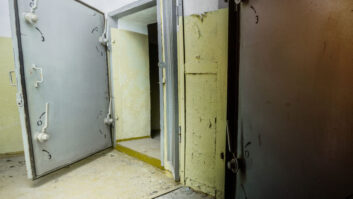Product CapsuleThumbs up:
Well-thought-out controls
Extensive I/O options
Thumbs Down:
USB connection only 1x
Case flap for connections
could be better designed
Price: $1,545
For more information contact HHB USA in California at (310) 319-1111, fax (310) 319-1311 or visit the Web site at www.hhbusa.comWhile it may seem that MiniDisc has become a dominant format for radio field recording almost overnight, that “almost” was, in fact, several years long.
After being introduced in the early ’90s, the format was floundering till the ATRAC 4.x codec was incorporated about two years ago. Suddenly, mini consumer recorders with near-CD audio quality flooded the market.
The relatively cheap machines suffered from the usual shortcomings of such gear. Inputs were limited to the usual 1/8-inch minijacks – typically powered for use with cheap electret microphones – which made it a challenge to attach professional dynamic mics.
Despite the need for workarounds and compromises, the consumer MD portables have pushed cassettes and DAT to near extinction. Now, the next wave of professional MD field recorders could finish the job.
Forward and upward
When I received word about the work HHB was doing developing what is now the MDP500 PortaDisc, I was invited to offer my “fantasy specs” for the concept.
Although the reality does not quite live up to that wish list, HHB has created a sturdy, serviceable field recorder that stands equal to its sibling, the now-discontinued PortaDAT. The company doesn’t consider this a direct replacement for the PortaDAT; it says it is bringing its ideas behind field equipment to a wider market.
The MDP500 has a familiar feel. It is about the same size as professional DAT and cassette recorders. The layout and feel of the controls are likewise comparable.
The transport controls and an integrated speaker/mic are on the top with an LCD screen and additional controls on the front. The right side has all the I/O connectors including three digital formats – two S/PDIF with both RCA and optical connectors and a USB port – analog balanced XLR inputs and RCA line outs, plus a 1/4-inch headphone jack and a connector for a remote control.
The biggest difference between this and other units is the slot for MD media on the left side. The back holds the eight “AA” cell battery pack. Fully loaded with batteries, the 10 x 2 x 7-inch package weighs about 4.5 lbs.
The demo unit seemed rugged and robust. With few moving parts, nothing rattles when you give it a shake. The unit comes in a kit with AC adapter, a set of high-capacity NiMH batteries and an extra battery holder. A car adapter kit is available.
Fit and finish
(click thumbnail)
When the MDP500 is put to use, the design shines. The transport controls have a nice “click.” Fingers can feel that the connection has been made.
A “keyhold” button disengages other controls and protects against accidentally stopping a session while making a recording. The front controls offer a similar lock feature with the recording level adjustment.
The rest of the front-panel controls cover a range of options. The setup button takes care of basics such as setting the onboard clock to timestamp recordings; setting the contrast on the LCD screen and controlling whether the LCD reads in peak-hold format.
The system button sets threshold levels for the auto-start recording/cutoff capabilities as well as a variety of additional options. The input button selects which elements of the I/O are initialized including phantom power, automatic gain control, a limiter, attenuator and high-pass filter.
Altogether, there is a plethora of options here, making this quite customizable to exploit the unit’s capabilities of the MD format. What I like most is that the control design here doesn’t rely entirely on clicking through menus.
Under the display, three buttons on the front-panel control selections on the options presented above. This can save a lot of fumbling.
Another thoughtful feature shows an understanding of how field recorders are used in real-life settings like a newsroom operation.
Reporters are not stuck with having to reset their preferences when sharing the unit with others. The internal memory stores five configurations of presets and options so that everyone can have it their way without hassles.
The included carrying case has clear panels to access transport and front-panel controls as well as to monitor levels on the LCD. The case comes with a handy pouch to store black discs, cables and other assorted items.
The only alteration I would suggest would be in the design of the flap over the I/O. To get an XLR mic cable and headphone plug in, you have to open the side’s Velcro-enclosed flap. It would be better if smaller panels opened to access just the XLRs and the headphone. Otherwise, this unnecessarily exposes all the connectors – a possible hazard under inclement conditions.
Hear to believe
Back in the studio, the audio can be offloaded to a computer through the USB port. The process of connecting the MDP500 to my Windows 2000 workstation was a no-brainer.
The operating system identified it as a USB audio device. I just changed the device option on the audio editor of choice on the computer and it was easy to record directly from the disc.
The advantage of USB over the S/PDIF or even analog outs is that you don’t need a soundcard to load recordings. On my original wish list, the USB connector would read the MiniDisc as a data drive – just drop and drag the audio into the DAW in seconds.
That would get past the real-time playback bottleneck so problematic when covering time-sensitive stories. One HHB representative at the AES show in Los Angeles last fall indicated that future versions may have a 4x read speed through the USB port.
The fact is that MD is probably not well-suited to this kind of use anyway. Sony dropped efforts to use MD as a data format – something of a competitor to ZIP drives – several years ago. It seems that MD has inherently slow access times.
Even though USB connectivity here does not allow better than real-time playback, it should be a boon to those working on Macs, particularly iMacs. A portable iMac and a PortaDisc would make a nice combo for the traveling broadcast journalist. Ditto for USB-equipped Windows-based laptops, too. Not having to add a pricey pro audiocard is a real savings.
The MDP500’s ATRAC 4.5 sounded just fine in both stereo and mono. As usual, the depth of ATRAC stereo seems a bit shallow to my ears. Typically, I use the mono settings anyway to extend the length of voice-only recordings.
With an estimated battery life of up to three hours on a charge, that will just cover the 160 minutes maximum on a single disc.
Speaking of sound quality, this was another one of my “dream” criteria. When better ATRAC versions are developed, you usually are married to the outdated one.
It would be nice to design this with an upgradable chip containing the codec so that the investment in all the other hardware can be extended as MD’s quality improves.
HHB is definitely on the mark with the MDP500. Though a first-generation pro MD recorder, it shows a deep appreciation for what is needed for fieldwork. The PortaDisc should quickly become the pro MiniDisc of choice much as the PortaDAT was when DAT ruled.













